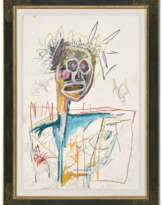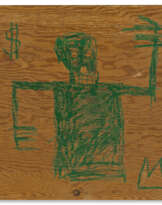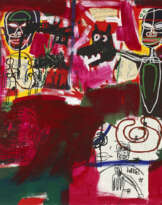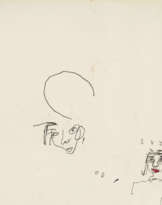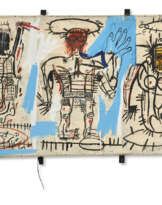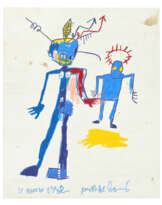ID 950147
Lot 6 | JEAN-MICHEL BASQUIAT (1960-1988)
El Gran Espectaculo (The Nile)
titled ‘EL GRAN ESPECTACULO’ (upper center); signed, titled and dated '“THE NILE” 1983 Jean-Michel Basquiat' (on the reverse)
acrylic and oilstick on canvas mounted on wooden supports, in three parts
overall: 68 x 141 in. (172.7 x 358 cm.)
Executed in 1983.
Provenance
Annina Nosei Gallery, New York
Enrico Navarra, Paris
Anon. sale; Sotheby’s, New York, 9 November 2005, lot 38
Acquired at the above sale by the present owner
Literature
M. Enrici, J. M. Basquiat, Paris, 1989, pp. 72-73 (illustrated).
R. D. Marshall and J.-L. Prat, Jean-Michel Basquiat, Paris, 1996, 1st edition, vol. 1, pp. 130-131 (illustrated); 2nd edition, vol. 1, pp. 180-181 and 395 (illustrated and titled as El Gran Espectaculo [History of Black People]).
Jean-Michel Basquiat, exh. cat., New York, Tony Shafrazi Gallery, 1999, pp. 194-195 and 319-320 (illustrated and titled as El Gran Espectaculo [History of Black People]).
A. Mazrui, C. Davies and I. Okpewho, eds., The African Diaspora: African Origins and New World Identities, Bloomington, 1999, pp. 447-448, fig. 3 (illustrated and titled as Untitled [History of Black People]).
Galerie Enrico Navarra, Jean-Michel Basquiat: Drawings, New York, 1999, p. 369 (detail view illustrated).
Terzoocchio, vol. 25, 1999.
R. D. Marshall and J.-L. Prat, Jean-Michel Basquiat, Paris, 2000, 3rd edition, vol. 1, pp. 174-175; vol. 2, pp. 162-163, no. 2 (illustrated and titled as titled as El Gran Espectaculo [History of Black People]).
Basquiat a Cuneo, exh. cat., Cuneo, Galleria d’Arte Il Prisma, 2001, p. 72 (detail view illustrated).
A. Marwick, The Arts in the West since 1945, New York, 2002, p. 296 (titled as El Gran Espectaculo [History of Black People]).
G. Lock and D. Murray, eds., The Hearing Eye: Jazz & Blues Influences in African American Visual Art, New York, 2009, p. 257.
K. Mercer, ed., Exiles, Diasporas & Strangers, Cambridge, 2009, pp. 136-137 (illustrated and titled as El Gran Espectaculo [History of Black People]).
Galerie Enrico Navarra (ed.), Jean-Michel Basquiat: Appendix, Paris 2010, pp. 34 and 45 (installation view illustrated and titled as El Gran Espectaculo [History of Black People]).
Basquiat, exh. cat., Basel, Fondation Beyeler, 2010, pp. 130-131, no. 137 (illustrated and titled as The Nile [El Gran Spectacle]).
V. Duponchelle, "Basquiat, l’artiste roi et sa couronne d’épines," Le Figaro, 1 June 2010 (titled as The Nile [El Gran Espectaculo]).
C. Remeseira, ed., Hispanic New York: A Sourcebook, New York, 2010, p. 438 (titled as Untitled [History of Black People]).
Basquiat and the Bayou, exh. cat., New Orleans, Ogden Museum of Southern Art, 2014, pp. 60-61, pl. 5 (illustrated and titled as El Gran Espectáculo [History of Black People]).
C. M. Tatum, ed., Encyclopedia of Latino Culture, vol. 1, Santa Barbara, 2014, p. 217 (titled as The Nile).
J. Saggese, Reading Basquiat: Exploring Ambivalence in American Art, New York, 2014, pp. 23, 36-38, 40, 47, 116, 138-139, and 107, pl. 14 (illustrated and titled as The Nile).
Words are All We Have: Paintings by Jean-Michel Basquiat, exh. cat., New York, Nahmad Contemporary, 2016, pp. 60-61, no. 8 (illustrated and titled as El Gran Espectaculo [History of black people]).
R. Iskin, ed., Re-envisioning the Contemporary Art Canon: Perspectives in a Global World, New York, 2017, p. 67, no. 2.3 (illustrated and titled as The Nile).
F. Hoffman, The Art of Jean-Michel Basquiat, New York, 2017, pp. 49, 56, 58-59, 62, 122, 148, 206, 212 and 244 (illustrated and titled as The Nile).
C.-M. Bernier, Stick to the Skin, Oakland, 2018, pp. 111-112, fig. 28 (illustrated and titled as [Untitled] History of Black People).
Jean-Michel Basquiat, Paris, Fondation Louis Vuitton, 2018, pp. 22, 40, 42-43, no. 2 (illustrated and titled as The Nile).
A. Vink, Postmodern Artists: Creators of a Cultural Movement, New York, 2019, p. 83 (titled as The Nile).
J. Saggese, ed., The Jean-Michel Basquiat Reader, Oakland, 2021, pp. 159, 168-169, 272, 305-306 and 314, pl. 25 (illustrated and titled as The Nile [El Gran Espectaculo]).
Exhibited
Paris, Galerie Enrico Navarra, Jean-Michel Basquiat: Paintings, Sculptures, Works on Paper and Drawings, November-December 1989 pp. 32-33 (illustrated).
New York, Whitney Museum of American Art, Houston, Menil Collection, Des Moines Art Center and Montgomery, Museum of Fine Arts, Jean-Michel Basquiat, October 1992-January 1994, pp. 23-24, 152 and 266 (illustrated and detail view illustrated; titled as Untitled [History of Black People]).
Paris, Galerie Enrico Navarra, Jean-Michel Basquiat, April-June 1996.
Kaohsiung, Museum of Fine Arts and Taiwan, Taichung Museum, January-June 1997, pp. 52-53 (illustrated).
Seoul, Gallery Hyundai, Jean-Michel Basquiat, July-August 1997 pp. 48-49 (illustrated).
Vancouver, Art Beatus, Jean-Michel Basquiat, September-October 1997, pp. 34-35 (illustrated and titled as El Gran Espectaculo [History of Black People]).
Tokyo, Mitsukoshi Museum and Marugame Genichiro Inokuma Museum of Contemporary Art, Jean-Michel Basquiat, October 1997-May 1998, pp. 18 and 50-51 (illustrated and detail view illustrated)
São Paulo, Pinacoteca, Jean-Michel Basquiat: Pinturas, June-September 1998, pp. 61-63 and 112 (illustrated and detail view illustrated).
Venice, Fondazione Bevilacqua La Masa, Basquiat a Venezia, June-October 1999, pp. 86-87 (illustrated and titled as El Gran Espectaculo [History of Black People]).
Rome, Chiostro del Bramante, Jean-Michel Basquiat: Dipinti, January-March 2002, pp. 86-87 (illustrated and illustrated on the exhibition poster; titled as El Gran Espectaculo [History of Black People]).
Paris, Fondation Dina Vierny-Musée Maillol, Jean-Michel Basquiat: Histoire d’une œuvre, June-October 2003, pp. 66-67 (illustrated and titled as El Gran Espectaculo [History of Black People]).
Cologne, Jablonka Galerie, Jean-Michel Basquiat: Paintings, October 2003-January 2004.
Mexico City, Museo del Palacio de Bellas Artes, Jean-Michel Basquiat, October-December 2004, pp. 46-47 (illustrated).
New York, Brooklyn Museum; Los Angeles Museum of Contemporary Art and Houston, Museum of Fine Arts, Basquiat, March 2005-February 2006, pp. 45, 52, 106, 135, 168, 170 and 177 (illustrated, detail view illustrated, and illustrated on the front and back covers of the Members Preview brochure; titled as The Nile).
Special notice
On occasion, Christie's has a direct financial interest in the outcome of the sale of certain lots consigned for sale. This will usually be where it has guaranteed to the Seller that whatever the outcome of the auction, the Seller will receive a minimum sale price for the work. This is known as a minimum price guarantee. Where Christie's has provided a Minimum Price Guarantee it is at risk of making a loss, which can be significant, if the lot fails to sell. Christie's therefore sometimes chooses to share that risk with a third party. In such cases the third party agrees prior to the auction to place an irrevocable written bid on the lot. The third party is therefore committed to bidding on the lot and, even if there are no other bids, buying the lot at the level of the written bid unless there are any higher bids. In doing so, the third party takes on all or part of the risk of the lot not being sold. If the lot is not sold, the third party may incur a loss. The third party will be remunerated in exchange for accepting this risk based on a fixed fee if the third party is the successful bidder or on the final hammer price in the event that the third party is not the successful bidder. The third party may also bid for the lot above the written bid. Where it does so, and is the successful bidder, the fixed fee for taking on the guarantee risk may be netted against the final purchase price.
Third party guarantors are required by us to disclose to anyone they are advising their financial interest in any lots they are guaranteeing. However, for the avoidance of any doubt, if you are advised by or bidding through an agent on a lot identified as being subject to a third party guarantee you should always ask your agent to confirm whether or not he or she has a financial interest in relation to the lot.
| Artiste: | Jean-Michel Basquiat (1960 - 1988) |
|---|---|
| Style artistique: | Art contemporain |
| Catégorie maison de vente aux enchères: | Peintures |
| Artiste: | Jean-Michel Basquiat (1960 - 1988) |
|---|---|
| Style artistique: | Art contemporain |
| Catégorie maison de vente aux enchères: | Peintures |
| Adresse de l'enchère |
CHRISTIE'S 8 King Street, St. James's SW1Y 6QT London Royaume-Uni | |
|---|---|---|
| Aperçu |
| |
| Téléphone | +44 (0)20 7839 9060 | |
| Commission | see on Website | |
| Conditions d'utilisation | Conditions d'utilisation |






